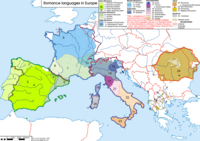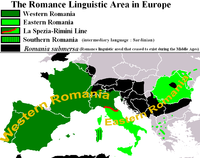Latin Europe
 European countries with a Romance language.
European countries with a Romance language.
| Area | 1,879,088.81 km² |
|---|---|
| Population | 217,054,426 |
| GDP (PPP) | $6,530,900,594,226 |
| Languages |
and other Romance languages |
| Religions | |
| Time Zones | GMT -1:00 (Azores, Portugal) to GMT +2:00 (Romania / Moldova) |
Latin Europe is a region of Europe, so-grouped through geographical and cultural affinity, drawing from Roman heritage after the spread of the Roman Empire.[1] Geographically anchored in Southern Europe, the area is dominated by Romance languages, or those with large input from them, while Roman Catholicism is the prevalent religion.[1] The majority of all countries of Latin Europe have status within the Latin Union. There is no clear definition on which countries or areas are included, but those which meet the geographical, linguistic, and religious criteria, are Portugal, Spain, France, Italy, and most of the European Microstates.[citation needed]
Geography and criteria
Latin Europe is seen as being a Southern European entity.[2][1] The countries touching the Latin Arch, as well as Portugal, and the landlocked microstates form the core of the region, although there are Southern European countries outside the Arch, such as Greece. The Greek language and religion do not fit in with the other characteristics of what constitutes the region however, so Greece is rarely grouped with it.
Western European Luxembourg, whilst matching the religious and linguistic characteristics of most Latin European countries, is rarely included. Its population usually speaks Luxembourgish, a German dialect, but the French language enjoys co–official status.
Language


A major aspect of what defines "Latin Europe" can be the use of a Latinate language – any language derived from Vulgar Latin after the spread of the Roman Empire.[1] These languages have more than 700 million native speakers worldwide, mainly in the Americas, Europe, and Africa, as well as in many smaller regions scattered through the world.
The most spoken Romance languages are Spanish, Portuguese, French, Italian and Romanian. As well as these being used as official, or even co-official languages in a number of countries, they also have significant unofficial use in a number of others. Malta for example, which in fact historically used Italian as its official language, has a large presence of it in the media, and 66% of the population speak it.[3] In addition to this, the Maltese language itself became so infiltrated with Italian words, that these now form the majority vocabulary influence in the language.[4] Such influence, usually to a lesser extent, is common in other languages in close contact with Latinate ones, warranting the linguistic inclusion of these areas too.[citation needed] In Vatican City, Latin, which was the very predecessor of the Romance languages, is used in many situations.
However, even within countries with a Romance language as an official language, there are often significant minority languages in some regions, such as Basque in Spain's Basque Country, which arguably militate against classifying such regions as Latin European. Switzerland has three official languages, two of which are Latinate (French and Italian) – while the third is Germanic (German). Thus, inclusion of Switzerland, and other multilingual countries, is often controversial. A similar situation has Belgium, where the Wallons encounter around half of the countries's population and Frech is one of the two official languages.
Religion
A significant Latin European cultural factor is the predominance of Roman Catholicism.[1] Vatican City has a 100% Catholic population and is the home of the Pope. Andorra, Spain, Portugal, France, Italy, Malta, San Marino, and Monaco are Latin European countries which share the religion as the clearly leading faith.
Romania and Moldova are the two Romance-speaking countries with an Eastern Orthodox majority. The Proto-Romanians remained under the rule and later the influence of the Eastern Roman Empire after the final partition of the Roman Empire in the year 395.
Around half or more of the French-speaking population in Switzerland are Calvinists.
Latin European peoples
- French people
- Italian people
- Romance-speakers of Iberia (see Ibero-Romance)
- Vlachs
- Rhaeto-Romance peoples
- Romansh people (speakers of Romansh)
- Friulians
- Ladins
- Sardinians
See also
References
- ^ a b c d e [1]
- ^ [2]
- ^ [3]
- ^ Brincat (2005)
- ^ Richmond, Yale. From Da to Yes: Understanding the East Europeans, p. 130 ("The vast majority of Transylvanians are ethnic Romanians"). Intercultural Press (1995), ISBN 1877864307
- ^ Boia, Lucian and Brown, James Christian. Romania: Borderland of Europe, p.29 ("The Moldavians are as much a component part of the Romanian nation as are the Muntenians – the Romanians of Wallachia"). Reaktion Books (2001), ISBN 1861891032
- ^ Levinson, David. Ethnic groups worldwide: a ready reference handbook, p.66 ("Romanians number 20.9 million in Romania and 3 million in neighboring Moldova") and p.56 ("The label Moldovan (or Moldavian) indicated nationality, as ethnic Moldovans are ethnically Romanian. Romanians (Moldovans) number about three million, or 65% of the population"). Greenwood Publishing Group (1998), ISBN 1573560197